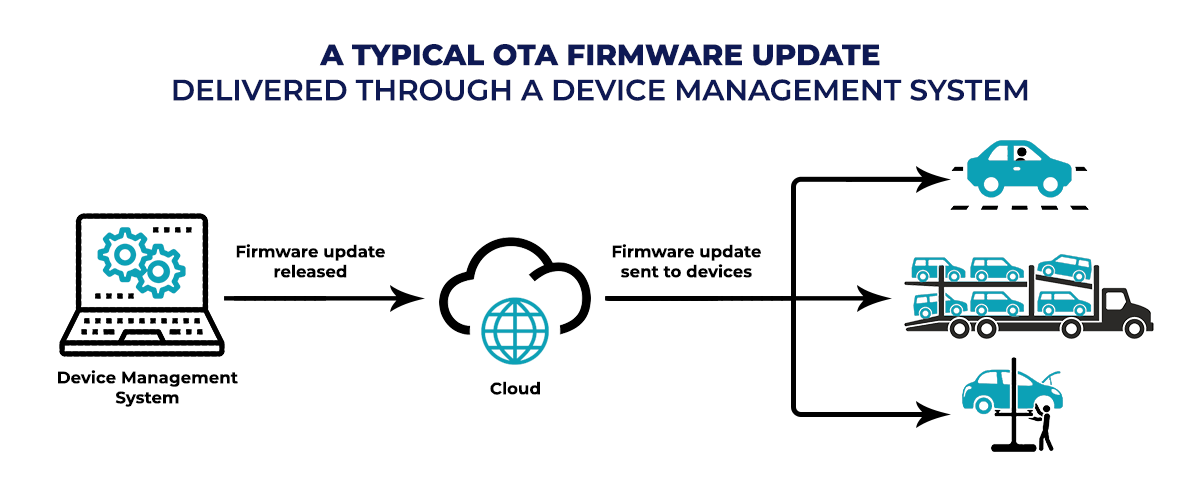The OTA Automotive
In the digital era, the Automotive industry is also gearing up to be more innovative, with vehicles becoming smarter and more intelligent. With the advent of Electronic Control Units (ECU) & Software Defined vehicles (SDV), the software/firmware has more control over a wide range of vehicle functionalities. Earlier, if there was a need for the vehicle to have a firmware update, the car had to be towed to the nearest service station and connected to the system for the updates. But it was an uphill task and not cost-effective for the consumers.
A vehicle’s Telematics Control Unit (TCU) is the device that oversees the OTA (Over the Air) updates transmitted over the wireless connecting the vehicle to the cloud services over a cellular network. The TCU collects the vehicle’s geographical coordinates, engine speed figures, and connectivity strength data. It also has an interface for mobile communication (4G/5G), an electronic processing unit, and a memory unit to store the vehicle’s sensor data.
Allied Market Research projects a $13.71 billion market for automotive over-the-air (OTA) by 2030, a fact that can help us realize the potential of OTA in the automobile industry.
How OTA Works in Automotive?
As the name suggests, updates from the Device Management System for vehicle functionalities and configurations are sent ‘over-the-air’ using this technology, which helps automakers introduce new features, fix bugs, patch vulnerabilities or enhance general software functionalities. The most common over-the-air software update types include SOTA (for software components) and FOTA (firmware).

OTA in Automotive Use Cases
Drive Control:
The drive control OTA updates are mission-critical and facilitate the vehicle’s ability to operate safely on the road. These regular firmware/software fixes and enhancements would ensure the vehicle system’s robustness, efficiency, and reliability throughout its lifetime. The drive control OTA updates include patches/enhancements to Powertrains Systems, Chassis, and Autonomous driving. Automobile manufacturers can push maintenance OTA updates to enhance vehicle power systems and rectify specific issues to improve operational efficiency. Automated Driving Systems (ADS) are still in the early stage, and ADAS(Advanced Driver Assistance System) is one of the significant developments in that space so far.
ADAS has five levels of automation & each level has its own set of features like Adaptive Cruise Control, Automatic Parking, Adaptive Light Control, Automatic Emergency Braking, Blind Spot Monitoring & much more. ADAS comprises numerous subsystems like ECU, sensors, and data, which are predominantly governed by software programs that need regular updates to function correctly. If the software patches are not provided on a timely basis, it might have adverse implications on the safety and security of the vehicle. This is where OTA comes into play and becomes instrumental in making ADAS more feasible & effective.
Automotive OEMs can push timely OTA updates for the ADAS-powered vehicles without rewriting the entire software program (Differential OTA update). However, all the OTA updates can’t be done while vehicles are in motion. For example, an update for navigation systems can be done while the vehicle is moving, but in case of an update for emergency braking demands, the vehicle has to be idle.
Infotainment:
Infotainment updates improve the in-vehicle digital experience, like map updates, audio upgrades, interface refreshes, new app versions, streaming services, enhancements, etc. In-Vehicle Infotainment (IVI) is increasingly becoming essential for automakers only next to safety, security, and efficiency. It helps to differentiate them from their competitors. The IVI solutions should include future compliance, robustness, cost factors, and flexibility to changing lifestyle demands amongst the customers, which the OTA updates could deliver.
OTA in Automotive Challenges
Since the OTA updates use a wireless connection, the connected vehicle could be the target of cyber-attacks. Vehicle interfaces could be exposed to malware and privacy theft. It would require the automotive OEMs to prioritize cybersecurity and privacy to mitigate the risks and gain customer confidence.
The OTA update also requires multi-disciplinary technologies like embedded electronics and IoT. This demands automotive OEMs to collaborate with the OTA solution providers like embedded electronic firms, IoT platform providers, and cybersecurity firms to improve their delivery capabilities.
Future Possibilities of Automotive OTA
As self-driving vehicle technology moves from Science fiction to Reality, the automakers are poised to make advancements in Automated Driving Systems (ADS) to ensure the smooth and safe running of the vehicles. Also, new compliance and safety standards are introduced from time to time, especially for ADAS and ADS, and OTA updates could be the savior in addressing these compliance issues without time delay.
The OTA updates are a win-win for both the automakers and the customers. As the vehicles become more technologically advanced and connected, the demand for OTA updates will rise since it provides for better, safer, and more compliant vehicles. With the introduction of Electric Vehicles (EVs) in the marketplace, the potential use of OTA updates could be manifold. Even EV scooter makers like Ola Electric had recently rolled out OTA called MoveOS 2, which fixes battery issues and brings many new features like mobile app control & cruise control. As vehicle intelligence also matures, the AI algorithms would be able to detect and transmit diagnostic and operational data from the vehicle systems and request vehicle updates through OTA.
The automotive industry has envisioned that the OTA technology would be the game-changer in their futuristic highway. Many of them have initiated their primary OTA offerings to the customers to enhance the in-vehicle digital experience and safety controls, including major automotive players like BMW, Volvo, Ford, and Mercedes-Benz. Agricultural equipment manufacturers like John Deere, AGCO Corporation, and CNH industrial have also initiated OTA updates for their tractors and mobile agricultural equipment.
What are the OTA technology benefits you are looking forward to? Enhanced drive control features, better security, reliable diagnostics, seamless infotainment or all of these?






